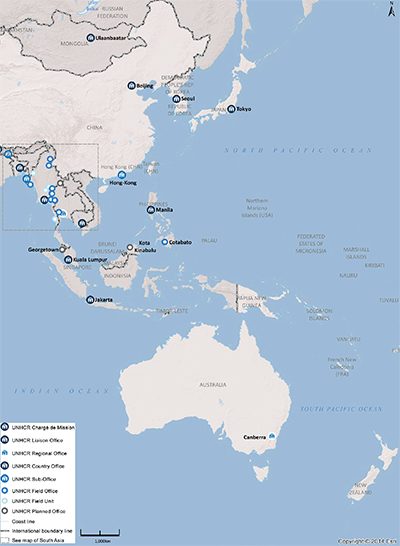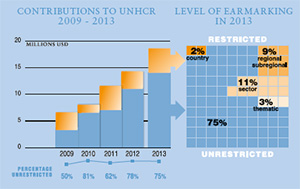Home > Where We Work > Asia and the Pacific > East Asia and the Pacific > Japan
2015 UNHCR subregional operations profile - East Asia and the Pacific
| Overview |
Mixed flows of urban asylum-seekers and migrants from South-West Asia, the Middle East and Africa continue to be the main protection feature in the subregion.
The central challenge for UNHCR is to assist States in shaping responses that balance concerns for border and migration control with the protection of asylum-seekers' rights.
The organization is pursuing dialogue with all relevant actors to foster regional cooperation rather than unilateral deterrence measures, and avoid people of concern being rejected at the border; to seek alternatives to the detention of asylum-seekers; and to discourage the development of restrictive asylum policies.
In Australia, restrictive policy changes introduced previously were further reinforced by the coalition Government elected in September 2013. The introduction of (regional) offshore processing in Papua New Guinea and Nauru in 2012, with no prospect of durable settlement in Australia, was combined with 'Operation Sovereign Borders' to implement the Government's policy of intercepting and returning boats to Indonesia.
The new Government reduced the humanitarian programme from 20,000 resettlement places in the fiscal year 2012-2013 to 13,750 places in 2014-2015, of which 6,000 are expected to be available for UNHCR-referred refugees. In September 2014, Australia and Cambodia signed a memorandum of understanding for the relocation of recognized refugees from Nauru to Cambodia.
In New Zealand, the overall climate for refugee protection remained positive, with a modest but well-managed resettlement programme and consistent financial support. However, legislation to deter boat arrivals came into force in 2013.
In Papua New Guinea, there have been positive steps toward integrating West Papuan refugees, including the announcement that the citizenship fee will be waived. A clearer legal basis for refugee protection is also being drafted in a new migration act. The Government is taking steps to lift its seven reservations to the 1951 Refugee Convention.
Pacific Island Countries are strengthening collaboration around border management and are gradually accommodating refugee protection into laws, policies and activities, while UNHCR continues to process the small number of asylum-seekers who move into the region. The organization will monitor policy and practice regarding detention in Australia and at the processing centres of Nauru and Papua New Guinea, and advocate for the application of international standards to the treatment of people of concern.
China is becoming a transit and destination country for mixed migration as a result of its geographical and economic importance. The operational environments in mainland China, and the Hong Kong and Macao Special Administrative Regions (SARs) continue to be at variance.
In mainland China, following the adoption of the Exit-Entry Administration Law in 2013,UNHCR will advocate that the Chinese authorities assume full responsibility for registration, refugee status determination (RSD) and durable solutions, in line with international standards.
In Hong Kong SAR, China, a unified screening mechanism (USM) to assess claims for protection against refoulement before executing removal orders became operational in March. As a result, UNHCR has ceased its asylum-screening procedures and refocused on providing the authorities with capacity-building assistance and closely monitoring USM implementation.
Macao SAR, China, is implementing refugee legislation through a refugees' commission, in consultation with UNHCR.
In Japan, the Ministry of Justice has established a sub-committee to review the country's asylum system, which is expected to introduce measures to improve the system's fairness and efficiency. UNHCR provides technical advice to the committee and will participate in drawing up the final recommendations. Following completion of a pilot phase, the Government has decided to start a formal resettlement programme in 2015.
Through public information and protection advocacy, UNHCR will pursue strong partnerships and support among decision-makers, non-governmental agencies and the public, to enhance international protection in Japan.
The asylum system in the Republic of Korea is relatively recent. UNHCR is thus helping to build national capacity with executive, judiciary and legislative bodies, as well as with the public and civil society organizations.
The Republic of Korea has recently expressed its willingness to become a resettlement country, a welcome development.
| Response and implementation |
In Australia and New Zealand, UNHCR will monitor decision-making processes, and use diplomatic and public advocacy to focus on preserving the non-discriminatory implementation of asylum, irrespective of how asylum-seekers arrive. The aims are to improve admission to RSD procedures, pursue alternatives to detention and expand the search for durable solutions.
UNHCR will support government efforts towards fair and efficient RSD procedures and consistency in decision-making at different instances.
The Office will monitor the implementation of bilateral arrangements between Australia and Papua New Guinea, and between Australia and Nauru, as well as the memorandum of understanding between Australia and Cambodia.
UNHCR will work to promote further public awareness of asylum and refugee protection issues in Australia and New Zealand, notably greater tolerance and understanding of the dynamics of forced population movements, including by sea.
In Papua New Guinea, UNHCR will facilitate durable solutions for West Papuan refugees, especially local integration, and will support the capacity of government and NGO partners to provide effective protection and assistance to non-Melanesian asylum-seekers and refugees.
Meanwhile States in the Pacific Island Countries, will receive UNHCR support to introduce protection safeguards in immigration procedures and establish and/ or reinforce RSD capacity through training.
In China, UNHCR will continue to balance the direct delivery of protection and assistance services to asylum-seekers and refugees with a move to providing greater advocacy and technical support for central and provincial authorities. The aim is to gradually capacitate the latter to take over responsibility for registration, asylum processing and the realization of durable solutions for those needing international protection.
Together with the Government, the Office will ensure that administrative structures and regulations for the new Exit-Entry Administration Law are in place. In the meantime, UNHCR will continue conducting RSD and providing legal counselling and social and material assistance to the most vulnerable refugees, until durable solutions are identified.
In Hong Kong SAR, China, UNHCR will monitor the unified screening mechanism, provide technical support to the authorities and help find durable solutions. Public awareness will accompany successful fund raising activities.
In Japan, UNHCR's refugee protection activities will support the authorities in refocusing their reception, RSD and local integration mechanisms, including by following up on the recommendations of the sub-committee on asylum.
The organization will undertake a range of awareness-raising activities, including public events such as the Refugee Film Festival with Japan for UNHCR, and external partners. UNHCR will strengthen its strategic partnership with Japan International Cooperation Agency.
In the Republic of Korea, the Office will advocate better access to the asylum system and social services for approximately 6,000 refugees and asylum-seekers. UNHCR will also support the Government's efforts to prepare for a resettlement programme.
The organization will target potential private donors with innovative campaigns, and intensify its contacts with the Korean business community to generate corporate-sector funding.
| Financial information |
In 2015, the overall financial requirements for the East Asia and the Pacific subregion have been set at USD 12.6 million.
In the Pacific, UNHCR has maintained a very modest budget despite the significant protection challenges the organization continues to face in the region.
In mainland China, more direct delivery of protection and assistance to an increasing population of urban refugees and asylum-seekers, as well as increased capacity-building activities, have resulted in higher financial requirements for 2015.
In Japan and the Republic of Korea, financial requirements will remain stable.
| UNHCR 2015 budgets for East Asia and the Pacific (USD) | ||||
|---|---|---|---|---|
| Operation | 2014 Revised budget (as of 30 June 2014) |
2015 | ||
| Refugee programme PILLAR 1 |
Stateless programme PILLAR 2 |
Total | ||
| Total | 13,786,402 | 12,204,212 | 425,746 | 12,629,958 |
| 1. Includes activities in New Zealand, the Pacific Island countries and Papua New Guinea. | ||||
| Australia Regional Office[1] | 2,631,314 | 1,976,523 | 0 | 1,976,523 |
| China | 4,734,380 | 3,951,597 | 188,448 | 4,140,045 |
| Japan | 4,010,561 | 3,748,439 | 68,584 | 3,817,023 |
| Republic of Korea | 2,110,146 | 1,993,552 | 168,714 | 2,162,266 |
| Regional activities | 300,000 | 534,101 | 0 | 534,101 |
Source: UNHCR Global Appeal 2015 Update
UNHCR contact information
| The UNHCR Representation in Japan | |||||||||||||||
|---|---|---|---|---|---|---|---|---|---|---|---|---|---|---|---|
| Style of Address | The UNHCR Representation in Japan | ||||||||||||||
| Street Address | Wesley Center 6-10-11, Minami Aoyama, Minato-ku, 107-0062 Tokyo, Japan | ||||||||||||||
| Mailing Address | Wesley Center, 6-10-11, Minami Aoyama, Minato-ku, 107-0062 Tokyo, Japan | ||||||||||||||
| Telephone | 81 33 499 2011 | ||||||||||||||
| Facsimile | 81 33 499 2272 | ||||||||||||||
| Website | http://www.unhcr.or.jp | ||||||||||||||
| jpnto@unhcr.org | |||||||||||||||
| Time Zone | GMT + 9 | ||||||||||||||
| Working Hours |
|
||||||||||||||
| Public Holidays | 01 January 2016, New Year's Day 29 April 2016, Showa Day 04 May 2016, Greenery day 06 July 2016, eid al fitr 18 July 2016, marine day 12 September 2016, Eid al Adha 19 September 2016, Respect for the Aged Day 10 October 2016, Health Sports day 23 December 2016, emperor's birthday |
||||||||||||||









